Civil justice statistics in Scotland 2022-23
Statistics on civil law cases in the Scottish courts together with other related information, such as statistics from the Scottish Crime and Justice Survey.
3. Civil justice problems
In this chapter we examine the types of civil legal problems people experience in Scotland, as determined by the Scottish Crime and Justice Survey 2021-22, and what sorts of issues are presented at court.
First we look at information from the representative sample in the Scottish Crime and Justice Survey. We then examine the trends in the courts’ data. Finally we look at the changes in legal aid sought in Scotland.
3.1 Scottish Crime and Justice Survey - civil justice module
The Scottish Crime and Justice Survey 2021-22 estimates that around three-in-ten adults experienced civil law problems in the three years prior to interview
The Scottish Crime and Justice Survey (SCJS) includes questions on experience of and response to civil law problems. Respondents are asked if they have experienced one or more of a list of problems or disputes in the three years prior to interview. They are then asked whether they have attempted to solve them. The Civil Justice tables are within Volume 2 Quarter sample modules in the latest SCJS publication.
Scottish Crime and Justice Survey figures for 2021-22 are used in this publication because the SCJS publication cycle was disrupted during the Covid-19 pandemic.
The problem areas covered are:
- home or family living arrangements
- money, finances or anything paid for
- unfair treatment
- health and well-being
The 2021-22 SCJS shows that around three-in-ten adults (28%) in Scotland were estimated to have experienced at least one of the civil law problems asked about in the previous three years. This is similar to both the 28% reported in 2019-20 and 30% reported in the 2008-09 SCJS. There have been some question updates and additional answer categories in the questionnaire since 2008-09, but results are still broadly comparable.
Some groups in the population were more likely to experience civil law problems than the general population. For example, an estimated 39% of those who are disabled experienced a civil law problem compared with 24% of those who are not disabled. Those aged 60 years and over were less likely to experience civil law problems compared with other age categories (17%, compared with 36% for 16-24, 37% for 25-44 and 26% for those aged 45-59). Victims of crime suffered a higher prevalence of civil law problems (45%) compared with non-victims (26%).
Among the problem areas listed above, 17% of adults had experienced problems with home or family living arrangements, 9% had experienced problems with money, finances or anything they had paid for, 6% had been treated unfairly in some respect and 6% had experienced health or well-being problems.
In line with previous years, the most common single problem was with neighbours, experienced by 12% of adults. The full breakdown is shown in Figure 4.
Figure 4: Problems with neighbours was the most common single problem encountered in the three years prior to interview
Experience of civil law problems in the last three years
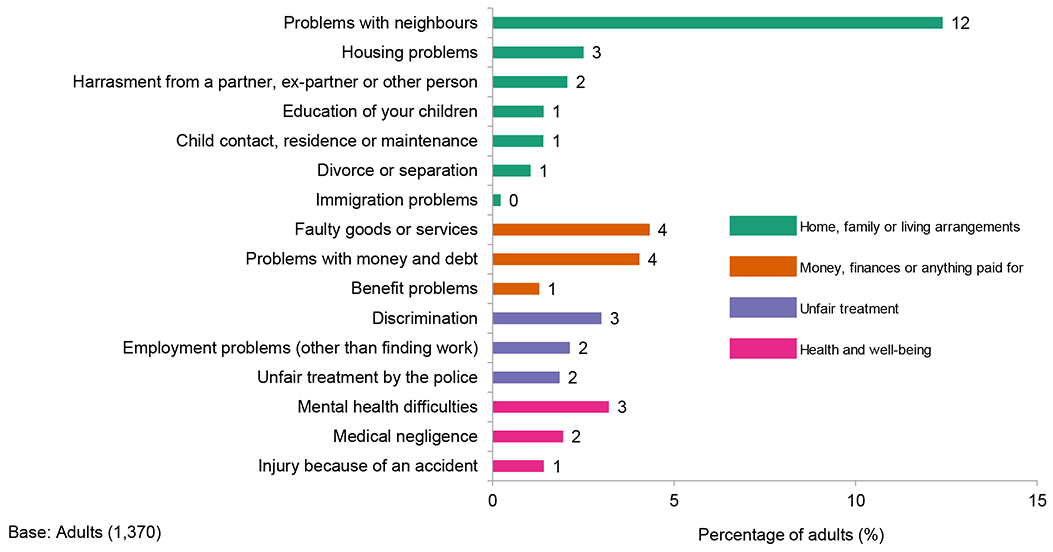
A bar chart showing results from the Scottish Crime and Justice Survey 2021-22 about respondents experience of civil law problems.
The most common issues relate to home, family or living arrangements; followed by money, finances or anything paid for; unfair treatment and health and well-being.
Among those who had experienced civil law problems in the last three years, 33% said a problem concerning neighbours was their most important or only problem to solve.
Just under three-in-ten (31%) of these civil law problems began less than a year ago, a further 22% over a year but less than two years ago, 23% over two years but less than three years ago and 24% over three years ago.
Just under two-in-five (38%) had resolved their problem, while just over a third (35%) were still trying to resolve the problem. 13% had tried to resolve their problem but had to give up and 11% were not planning to do anything.
Scottish Crime and Justice Survey defined problems which correspond to those commonly handled by the civil courts are summarised in the following sections:
Debt (section 3.2.1) - An estimated 4% of adults in the 2021-22 SCJS reported having money and debt problems. Those with a disability had higher prevalence of money and debt issues (9%), in comparison with 3% of those without disability.
Family (section 3.2.3) - The 2021-22 SCJS found that an estimated 2% of adults experienced problems to do with the behaviour of a partner, ex-partner or other person harassing them, 1% experienced a problem to do with child contact, residence or maintenance and similarly 1% experienced problems to do with divorce or separation.
Personal injury (section 3.2.4) - The 2021-22 SCJS found that an estimated 2% of respondents experienced a medical negligence issue and 1% experienced a personal injury problem in the last three years.
3.2 Volumes and types of problems in the courts
In this section we examine the types of civil law problems recorded in court statistics, and any changes in their likelihood over time.
Since 2018-19, in addition to the principal crave of cases in the sheriff courts, we now publish statistics on ancillary craves. An individual case can involve a number of different legal remedies sought by the pursuer. The requirement that is listed first on the writ is normally known as the principal crave, for example ‘divorce’, and is used to categorise the case type. The others remedies sought are described as ancillary craves, for example ‘contact’.
Figure 5: Debt cases remain the most common problem (principal crave) at civil courts in 2022-23
Proportions of civil court case types initiated in 2022-23
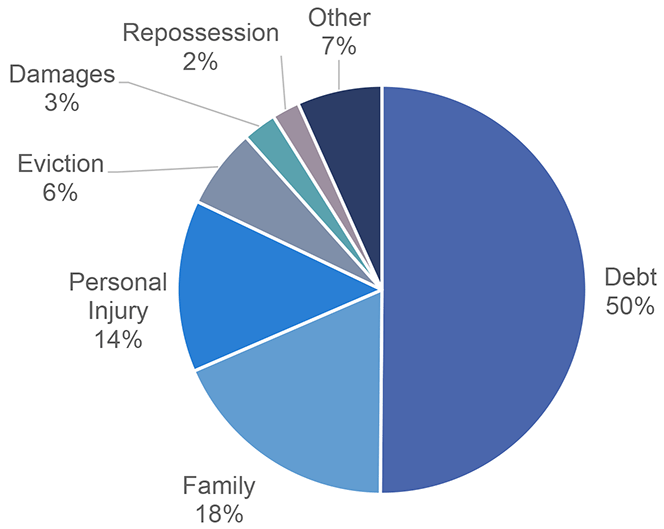
A pie chart showing the proportion of the types of cases going through the courts. Debt is the most common (50%), family (18%), personal injury (14%), eviction (6%), damages (3%) and repossession (2%).
In 2022-23, debt actions were the most common principal crave, constituting 50% of all civil court cases. Family and personal injury actions were second and third most common, at 18% and 14% respectively (Figure 5) (percentages include summary applications for repossessions similar to Figure 1. The rest of the statistics in the publication excludes them).
By including ancillary craves, our statistics capture the full detail of orders the courts are required to make under each case type. Table A1 to Table A10 show the counts of craves, while Figure 6: Family, repossession and eviction cases are more likely to have multiple craves compared to other case categories shows a summary of the complexity of cases based on the number of craves attached to them by principal crave type. This craves analysis is based on cases initiated in 2022-23.
As shown in Figure 6, family cases (except divorce/dissolution) are more likely to have multiple craves, compared to other case categories. Family-other and parental responsibilities and rights have both 38% of writs with two or more craves. Outside family law, we note that 36% of eviction and 12% of repossession cases have more than one crave on their writ. Overall, 90% of initiated cases had a single crave on their writs.
Figure 6: Family, repossession and eviction cases are more likely to have multiple craves compared to other case categories
Sheriff court cases by the number of initiated craves 2022-23
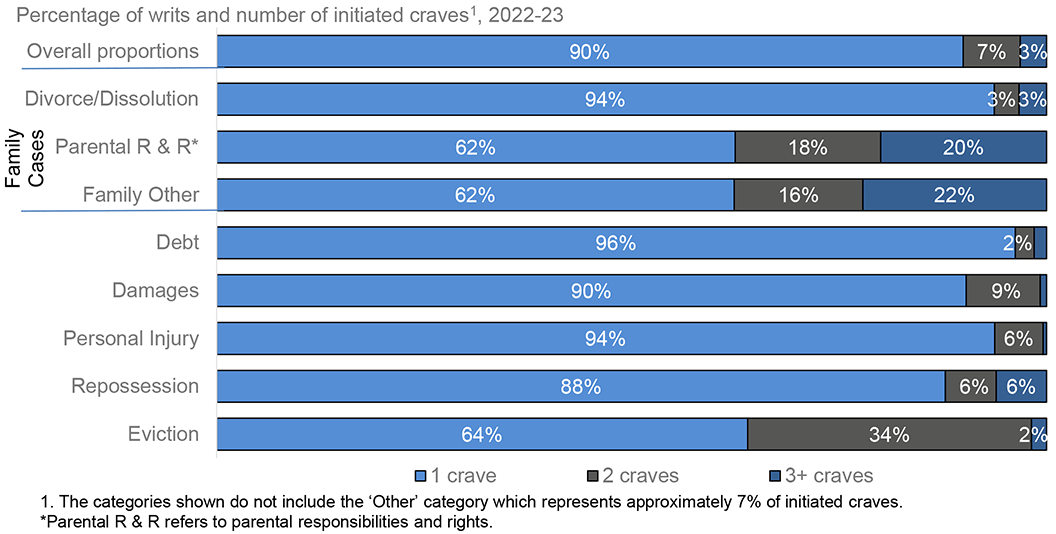
A compound bar chart showing the percentage of writs with one, two and three or more craves initiated by different case types for 2022-23.
Family, repossession and evictions are more likely to have multiple craves compared to other case categories.
3.2.1 Debt
Debt cases made up 51% of principal craves initiated at civil courts in 2022-23
In line with overall cases, debts recorded increased from 2021-22 and are nearly at pre-pandemic levels
85% of debt cases initiated in 2022-23 were under the simple procedure
Money owed to an individual or organisation is known as a debt and can include council tax, business taxes, hire purchase agreements, utility bills, bank overdrafts and loans. Where there is a dispute over a debt and a creditor wishes to enforce their right for payment, they can raise a debt case in court.
The Scottish Legal Aid Board, in their fifth monitoring report, found that: “Other routes to debt management or resolution of the debt issue, not involving court, are increasing in importance. Debt management companies and the not-for-profit sector appear therefore to be an increasingly important avenue for people seeking assistance with debt issues other than solicitors.”
Evidence
Debt actions have consistently been the most common principal craves over the past 10 years.
The number of debt cases in 2022-23 increased by 16%, continuing the trend from the previous year. Case numbers are near pre-pandemic levels, and have risen from 26,978 to 31,225.
Of these 31,225 debt actions initiated in 2022-23, 85% were brought to the sheriff court under the simple procedure, the same proportion as the previous year. A very small number were summary cause proceedings. Fourteen per cent were brought to the sheriff court under ordinary cause procedure, the same proportion as in 2021-22.
Having generally decreased in the earlier part of the last 10 years, debts have seen a more fluctuating pattern in recent years. A sharp drop in numbers in 2020-21 due to the pandemic was followed by successive increases in the following two years in line with overall case numbers. Debt levels are nearly matching pre-pandemic volumes (Table 12).
Table A1 and Table A2 present the statistics which show counts of all craves on debt cases initiated in 2022-23. The most common craves are payment of money (31,317), expenses (380) and damages (221).
Figure 7: Debt cases initiated have recovered and are closer to pre-pandemic levels
Debt cases initiated in the civil courts, 2013-14 to 2022-23
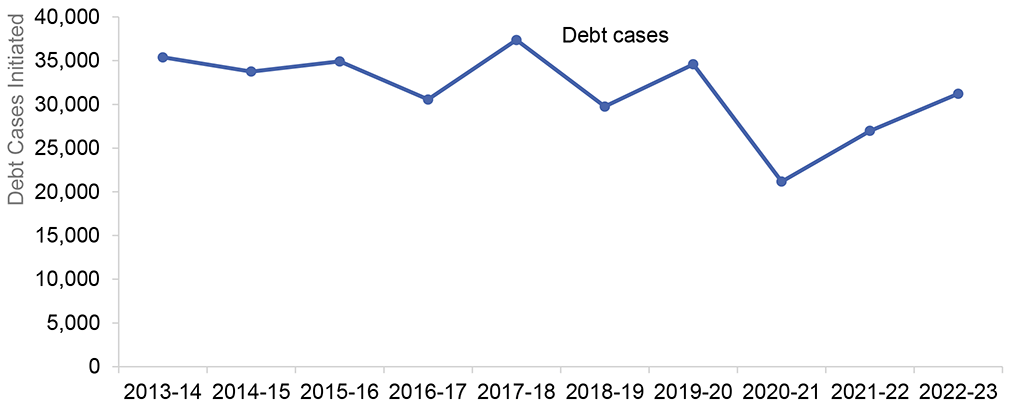
A line graph showing a time series of debt cases initiated between 2013-14 and 2022-23. Debts are rising again following the low levels during the pandemic
3.2.2 Eviction
Eviction actions initiated made up 6% of principal craves initiated at civil courts in 2022-23
Evictions initiated in 2022-23 are still very low compared to pre-pandemic levels, but are rising each year since their record low in 2020-21
Eviction cases involve the taking of property by the owner from an occupier, usually a tenant. Landlords can apply to the civil courts for an eviction order if they want their tenants removed from the property.
From 1 December 2017, all civil private rented sector eviction cases, including short assured, assured and private residential tenancies are dealt with by the First Tier Tribunal Housing and Property Chamber (criminal cases remain with the sheriff court).
The eviction statistics in this bulletin relate to tenants of rented properties in social housing (local authority and registered social landlords) and private sector tenants prior to 1 December 2017. Detailed statistics on the eviction of local authority tenants are available from Housing Statistics for Scotland.
Initiating eviction action for social housing (local authority and registered social landlord) rent arrears cases can only happen after the landlord has followed a set of pre-action requirements. By granting an eviction order, the courts permit the eviction process to proceed, but this does not mean that eviction will necessarily take place.
Emergency coronavirus legislation was put in place from 7 April 2020 until 30 March 2022 to extend the period of notice social landlords were required to give their tenants before the landlord could raise eviction proceedings in court. This was a temporary public health protection measure, aimed at ensuring people could stay safe in their homes for as long as possible. In most cases, this extended notice period was 6 months. This measure and the increased commitment from social landlords to only take eviction action when absolutely necessary had a substantial impact on the number of eviction actions initiated in 2020-21 and 2021-22.
Evidence
In 2022-23, eviction actions initiated rose by 128%, from 1,730 to 3,945 although they remain 63% lower than pre-pandemic levels (10,520) (Table 23). The low level of initiations during the pandemic years is largely due to the emergency legislation which protected tenants during the pandemic, brought into force in April 2020 as part of Coronavirus (Scotland) Act 2020. In addition, the Ending Homelessness Together Action Plan published by the Scottish Government in November 2018 increased the focus in the social rented sector on eviction prevention. Around 55% eviction cases disposed of in 2022-23 were dismissed (Table 24).
From 2013-14, eviction initiations were increasing to a peak of 14,690 in 2015-16, followed by a levelling off until 2017-18. Since 2018-19, initiations have been falling, partly due to private rented sector statistics moving to the First Tier Tribunal Housing. However, the decrease was rapid during the pandemic. The latest two years saw some recovery in initiations but they still remain far below their pre-pandemic volumes.
All evictions are brought to the sheriff court as summary cause actions.
Table A1 and Table A3 show a count of all craves for eviction cases initiated in 2022-23. The most common craves sought are Recovery of heritable property (2,664), Payment of money (1,451) and Repossession (646).
Figure 8: Eviction actions initiated in 2022-23 rose from the previous year but still far below pre-pandemic levels
Eviction cases initiated in the civil courts, 2013-14 to 2022-23

A line graph showing a time series of eviction cases initiated between 2013-14 and 2022-23. Evictions have been decreasing in recent years but fell rapidly during the pandemic due to emergency legislation protecting tenants from eviction. Evictions rose in 2022-23 but still far below pre-pandemic levels.
3.2.3 Family
Divorce and dissolution made up 75% of family cases initiated in 2022-23
Nearly all of the 7,488 divorces granted in 2022-23 were heard in sheriff courts, and 60% used the simplified procedure
Family law covers a wide range of areas related to families, couples and children. These include: divorces and dissolutions; applications relating to parental responsibilities and rights; and permanence and adoption cases.
Family law also covers interdicts preventing a party from making specific contact or coming within close proximity to another, and exclusion orders that suspend the rights of an individual to live in the family home.
This section also contains statistics on sheriff court summary applications relating to adoption and children’s hearings.
Previous editions of this bulletin presented statistics relating only to the principal crave of cases. This meant that the statistics on certain case types, such as contact and residence, did not reflect the true number of actions brought to court as these issues are often ancillary craves in a case where the principal crave is for divorce. We now publish statistics counting all the craves associated with a writ.
Table A1, Table A4, Table A5, Table A6 and Table A10 contain counts of all craves relevant to family law cases. The most common specific craves on divorce/dissolution cases are Divorce (8,424), Expenses (232) and Capital Sum (126). On parental responsibilities and rights cases, the most common are Contact (1,069), Residence of child (963) and Parental responsibilities and rights (478). Family-Other has Interdict (281), Declarator (143) and Residence of child (77) as the most common specific craves sought.
Family law evidence summary
There has been a general downward trend in the number of family actions as principal craves since 2013-14, with the decline in divorces being the biggest contributor. There was a 17% fall from 13,853 in 2013-14 to 11,445 in 2022-23 (Table 5). Family is the only case type to experience a decrease in initiations in the last year (down 7% or 869 cases).
Figure 9: Divorce and dissolutions constitute the majority of family cases
Family cases initiated in civil courts by type, 2022-23
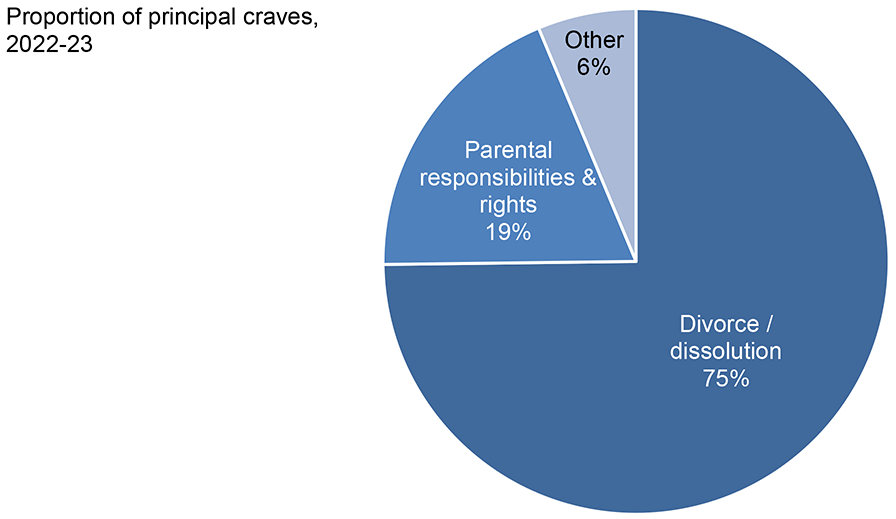
A pie chart showing the different types of family cases initiated and their proportions in 2022-23. Divorce and dissolution accounted for 75% of cases, parental responsibilities & rights (19%) and other 6%.
Divorce / dissolution and parental responsibilities and rights are the biggest case types, and together account for 94% of family cases initiated.
Only a small proportion of family cases are heard in the Court of Session (112 or 1% in 2022-23), representing 11% of cases in the General Department of that court (Table 2 and Table 6). Of these 112 cases, divorces and dissolutions accounted for 80 or 71%.
In 2022-23, the vast majority (95%) of applications to extend/vary an interim order disposed of were granted. Similarly, most children’s hearings (referral applications) disposed were granted (91%) and established the grounds for referral, with the case being referred back to the Children's Hearing to dispose of the case (Table 8).
In 2022-23, there were 509 adoption petitions initiated, an increase of 13% on the previous year. The number of applications initiated for permanence orders increased by 1%, to 305 in 2022-23.
Divorce and dissolutions statistics
Divorce is the formal procedure that ends a marriage, while the procedure for ending civil partnerships is known as dissolution. In addition to divorce and dissolution, the courts can also take decisions on where a child should live when parents separate; whether the non-resident parent should have contact with the child and who should have parental responsibilities and rights. Where children are involved, or there is a claim for financial provision, the ordinary procedure is used. However, the majority of divorces and dissolutions use a simplified procedure which is low-cost and simpler.
The divorce and dissolution statistics presented in Table 9, Table 10 and Table 11 are based on different Scottish Courts and Tribunals Service data from the other statistics in this bulletin. See the section 5.6 for more information.
Historical statistics, broken down by characteristics such as age at marriage/partnership, age at divorce/dissolution, duration and form of marriage/partnership where they are available, are published as supporting files alongside the relevant bulletin on the website within the Civil Justice Statistics section. Equivalent statistics for 2022-23 are available in Excel Tables published alongside this bulletin.
Divorce and dissolution of a civil partnership
The Civil Partnership Act 2004 came into force on 5 December 2005, allowing legal relationships between two people of the same sex to be formed. The first civil partnerships in Scotland were registered on 20 December 2005. Following the Civil Partnership (Scotland) Act 2020, mixed sex civil partnership has now been introduced in Scotland and the first mixed sex civil partnerships took place in June 2021.
On 12 March 2014, the Marriage and Civil Partnership (Scotland) Act 2014 received Royal Assent. Following this Act, the first same-sex marriage ceremonies took place in Scotland on 31 December 2014. In addition, couples in civil partnerships are able to change their relationship into a marriage.
Following on from the Marriage and Civil Partnership (Scotland) Act 2014, we are now publishing, divorces granted, split by mixed sex and same sex (Table 9) and divorces granted by method of celebration, also split by mixed sex and same sex (Table 11).
The latest data on marriages and civil partnerships registered can be found in the Marriages and Civil Partnerships section of the National Records of Scotland website.
Divorce & dissolution evidence
The number of divorces has been slowly decreasing from 13,365 in 1985 to 7,744 in 2022 (Figure 10). This decrease could be linked to the general downward trend in marriages across the same period as shown by the chart. The main exception to this trend was a sharp rise in divorces in 2006. This rise can be attributed to the reduction in non-cohabitation periods required to prove irretrievable breakdown of a marriage brought into force by the Family Law (Scotland) Act 2006. Data prior to 2008-09 cannot be compared directly with later data, and is discussed here to provide historical context. See the Quality of statistics section.
The total number of divorces granted in Scotland in 2022-23 was 7,488, 9% lower than in 2021-22 (8,251) (Table 9). In 2022-23, 60% of divorces granted used the simplified procedure. There were 121 divorces granted to same sex couples.
There were 43 civil partnership dissolutions granted in 2022-23, 31% decrease from 62 in 2021-22 (Table 10). The vast majority of dissolutions granted in 2022-23 (79%) used the simplified procedure.
Figure 10: Downward trend for both divorces1 and marriages1 since 1985. Sharp rise in marriages for the last two years, catching up from pandemic restrictions
Marriage and divorces trends, 1985 to 2022

A line chart showing the number of divorces and marriages plotted alongside each other from 1985 to 2022. Generally divorces and marriage trends follow a similar pattern.
3.2.4 Personal injury
There was a 12% increase in personal injury cases initiated in 2022-23 compared to 2021-22
Just under half (49%) of personal injury cases were raised in the national Sheriff Personal Injury Court
64% of personal injury cases were in relation to road traffic accidents
Personal injury can be physical and/or psychological, and include disease or impairment. Personal injuries may result from a wide range of causes including an injury received at work, a traffic accident, or through negligence or a deliberate act on the part of another party. A person who has suffered an injury can seek redress through several routes, such as making a complaint against the person/organisation they consider to be responsible for the injury, seeking assistance with any financial problems they have as a result of their injury, or seeking counselling. Alternatively, they may wish to claim compensation, provided certain criteria are met to cover losses they have suffered as a result of the injury.
A personal injury case is a form of damages case that relates specifically to damages for, or arising from, personal injuries or the death of a person from personal injuries. Other cases, for example defamation, are covered under damages in section 3.2.5.
Evidence
With the exception of 2020-21, there has been between 7,600 and 9,500 personal injury cases initiated as principal craves each year. In 2022-23, there were 8,474, up 12% from 2021-22 (Table 14). Personal injury has seen a high degree of variation over the last 10 years, with noticeably lower volumes in 2020-21 and 2021-22. The latest figures are more in line with pre-pandemic levels.
Figure 11: Personal injury cases fluctuate year-on-year, but road traffic and accident at work are the most common
Personal injury cases initiated in civil courts, 2013-14 to 2022-23

A compound bar graph showing the volume and types of personal injury cases for the period 2013-14 to 2022-23. Road traffic accident and accident at work are the most common.
The prevalence of personal injury cases as a proportion of all principal craves has remained the same as in 2021-22, at 14%.
There have been changes in the procedures used to hear personal injury cases since 2021-22. Just under half (49%) went to the Sheriff Personal Injury Court (up from 44%) and 23% were brought to the sheriff courts as ordinary cause (down from 26% in 2021-22). 22% were brought under summary cause to the sheriff courts (up from 18%), and 6% to the Court of Session (down from 12%).
There are differences in how different types of personal injury are using procedures in the courts, as shown in Figure 12.
The Sheriff Personal Injury Court is increasingly likely to cover accidents at work and Asbestos-related cases, with at least 74% of each of these cases using the specialised court in 2022-23.
The majority of accident at work cases in 2022-23 (down 166 to 1,391) were initiated at the Sheriff Personal Injury Court. 88% of accident at work related cases were raised at this court, higher than in the previous year when it was 81% (Table 18).
There has been a decrease in asbestos cases since the previous year (down 143 to 427). A large proportion of these were brought to the Sheriff Personal Injury Court. This year the proportion increased from 68% to 74%.
There were 234 clinical negligence cases initiated in 2022-23, a 32% decrease from the 343 cases last year. The number of initiations have fluctuated over the years since 2013-14 (Table 14).
Table A1 and Table A7 show counts of craves associated with personal injury cases initiated at the sheriff courts in 2022-23. The most common craves sought are Damages (7,842), Payment of money (292) and Expenses (237).
Figure 12: Accidents at work and asbestos cases are most likely to use the Sheriff Personal Injury Court
Procedures used on different personal injury case types, 2022-23
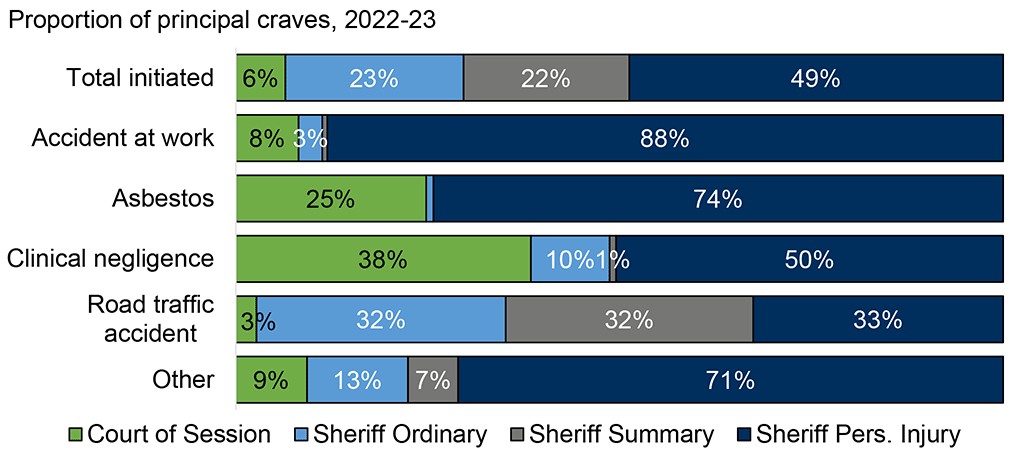
A compound bar chart showing the types of personal injury cases initiated in 2022-23 and the procedures used on them. Asbestos and accident at work are more likely to use the Sheriff Personal Injury Court. Clinical negligence cases have the highest proportion of cases going to the Court of Session.
3.2.5 Damages
The number of damages cases increased by 28% from 2021-22
80% of damages cases were initiated under ordinary cause in 2022-23. 54% of the ordinary cause cases disposed of had a decree of absolvitor.
72% of damages cases disposed of in the Court of Session had a decree of absolvitor
Damages are a legal remedy that provide compensation for harmful actions suffered through the fault of another party, either an individual or an organisation. A claim for damages can arise from all sorts of circumstances and include (but is not limited to): defamation, breach of contract, damage to moveable property, negligence, breach of warranty or guarantee, breach of trust, wrongful diligence, wrongful interdict, malicious prosecution, wrongful apprehension or false imprisonment or fraudulent representation and personal injury. For the purpose of these statistics, the definition for damages does not include personal injuries, which are covered separately in section 3.2.4.
The purpose of a damages case is to provide a remedy by measuring, in financial terms, the harm suffered to restore an injured party, as far as practicable, to the position they were in beforehand. The court has responsibility for assessing the damage and agreeing or modifying the damages proposed by the pursuer as it sees fit.
Evidence
In 2022-23, initiated cases rose to 1,670. This is among the lowest in the last 10 years, although it has increased by 28% from 2021-22 (Table 19).
From 2013-14 until 2015-16, there was a year on year fall in the number of damages claims initiated as principal craves. This was followed by a gradual increase in numbers until 2019-20 when they reached their peak for the 10 year period. There was a sharp drop during the pandemic and initiations have not recovered from the record lows.
Of the 1,670 damages actions initiated, 18% were brought to the sheriff court under the simple procedure, slightly up from 17% in the previous year. The low volume of initiations for the third year running is due to the low numbers in simple procedure in comparison with when the procedure was initially introduced. Nearly all summary cause actions were absorbed by the simple procedure. 74% of cases were brought to the sheriff court under ordinary cause procedures, up from 70% in 2021-22 (Figure 13).
Table A1 and Table A8 show the counts of all the craves associated with damages cases initiated in 2022-23. The most common craves sought are Damages (1,499), Expenses (120) and Payment of money (77).
Figure 13: Other procedure for damages have overtaken simple procedure in recent years
Damages cases initiated by procedure, 2013-14 to 2022-23
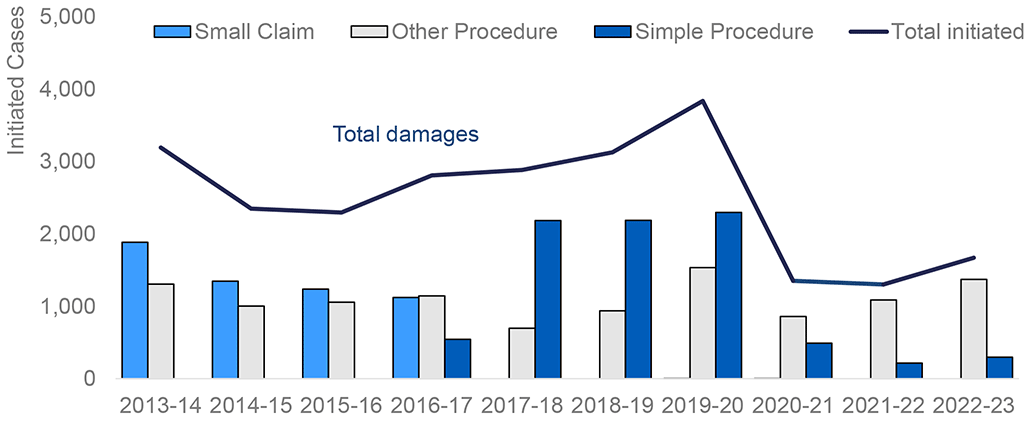
Multiple bar charts between 2013-14 and 2022-23 showing the types of procedure used on initiated damages cases. A line chart showing the total number of damages is plotted on the same axis.
3.2.6 Repossession
After a large Covid-related fall in 2020-21, repossessions increased by a further 14% in 2022-23, building from 2021-22. This brings them closer to pre-pandemic levels. However, initiations are still 39% lower than 2019-20.
Repossession involves the retaking of property when a borrower is in breach or default of a mortgage or loan secured on the property. Repossession should not be confused with eviction which, for the purposes of these statistics, refers to the removal of tenants from a rented property (see section 3.2.2).
Historically, repossession cases relating to mortgages and loans were dealt with under ordinary cause procedure. However, the introduction of the Home Owner and Debtor Protection (Scotland) Act 2010 on 30 September 2010 led to these cases being raised instead as summary applications. Where a repossession case relates to non-residential land or property, the action may be raised either as a summary application or as an ordinary action. If successful, the pursuer has the right to take possession of the property.
During the pandemic, the Financial Conduct Authority and mortgage lenders also put temporary support measures in place such as payment deferrals which protected homeowners in financial difficulty from repossession. These measures had a substantial impact on repossessions initiated in 2020-21, which were the lowest on record.
Evidence
After a large Covid-related fall in 2020-21, followed by some recovery in 2021-22, initiated cases increased to 1,352, rising by 165 or 14%. This increase brings the initiations closer to pre-pandemic levels, but still 39% lower than 2019-20. Non-residential property were raised under ordinary cause and residential property used summary application.
Repossessions were at their highest (4,770) in 2013-14, and decreased consistently until 2016-17. Following the decrease, they fluctuated around 2,000 per year until the record low in 2020-21 (Table 21).
Figure 14: Repossessions rose in 2022-23 from the previous year but still below pre-pandemic levels
Repossessions cases initiated by procedure, 2013-14 to 2022-23
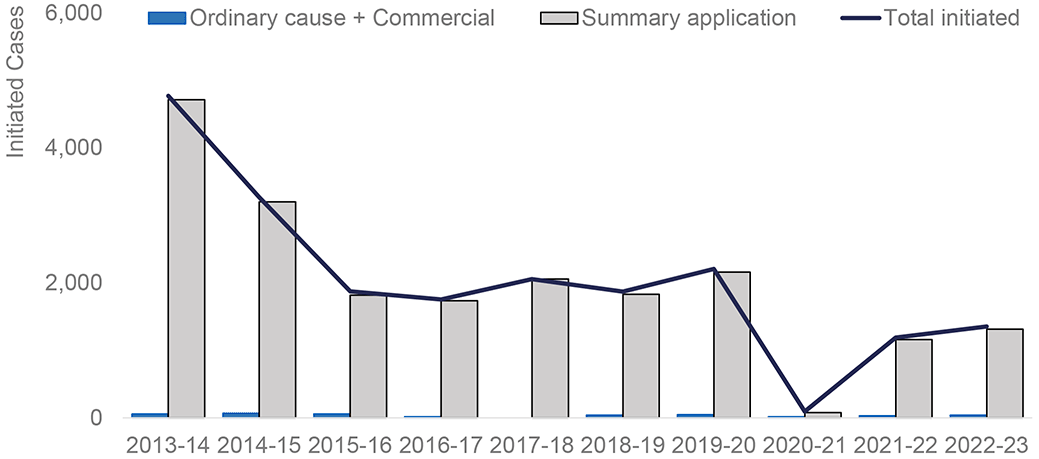
Multiple bar charts between 2013-14 and 2022-23 showing the types of procedure used on initiated repossession cases. A line chart showing the total number of repossessions is plotted on the same axis.
In 2022-23, 57% of repossession disposals were granted (Table 22). It is important to note that the granting of a repossession case means the court has permitted repossession to take place, but the order may ultimately not be enforced.
Table A1 and Table A9 show the counts of craves associated with repossession cases initiated in 2022-23. The most common specific craves sought were Repossession (1,344), Expenses (101) and Declarator (22).
3.3 Civil legal aid
In 2022-23, there were 13,149 civil legal aid grants, the vast majority of which were for cases in the sheriff courts
The Scottish Legal Aid Board (SLAB) administers legal aid, which is paid for out of public funds and helps towards the costs of legal advice and representation for those who qualify. It is designed to help individuals who would be unable to pay on their own to gain access to the legal system.
There are two main types of civil legal assistance: advice and assistance (including assistance by way of representation) and civil legal aid. Advice and assistance helps pay for advice from a solicitor on any matter of Scots law. Civil legal aid helps pay for a solicitor to take the case to court.
Evidence
The number of legal aid applications were relatively stable but in a general downward trend in the six years prior to 2020-21. The large fall in applications in 2020-21 can be attributed to general behavioural changes due to lockdowns. Applications went up in 2021-22 and remained stable in 2022-23, but still lower than the pre-pandemic volumes. Grants were mostly on a stable upward trend before the pandemic, meaning more applications being approved for funding. This is partly due to a rise in applications for Adults with Incapacity cases which have a high success rate. The grants for 2019-20 nearly matched the peak recorded in 2009-10, before falling in line with applications in 2020-21. Grants awarded fell in 2022-23; this corresponds to a small drop in applications during the same period.
In 2022-23, there were 13,149 civil legal aid grants (Table 29), the vast majority of which were for cases in the sheriff courts. After steadily rising for over 10 years, legal aid grants in relation to intervention orders and guardianship orders under Part 6 of the Adults with Incapacity (Scotland) Act 2000 now represent the largest category of legal aid certificates issued, at 44% of all grants. The next largest category is contact/parentage, which accounted for 17% of all grants in 2022-23.
Figure 15: More applications are being granted legal aid, narrowing the gap between applications and grants
Civil legal aid applications and grants, 2008-09 to 2022-23

A line chart plotting applications alongside grants for civil legal aid between 2008-09 and 2022-23. The line chart shows that more grants are being awarded, narrowing their gap with application
Applications and grants in any one year may not relate to the same cases because of the interval between an application and a decision to grant. Also note that granted cases may not always proceed.
SLAB manages three grant funded programmes for projects across Scotland to enable support for people affected by repossession, eviction, debt problems and other financial needs. In 2022-23 these programmes enabled 3,764 clients to access help and provided representation at court or tribunal on 1,443 occasions.
Further information and data on legal aid is available from the Scottish Legal Aid Board Annual Report 2022-23.
Contact
Email: justice_analysts@gov.scot
There is a problem
Thanks for your feedback